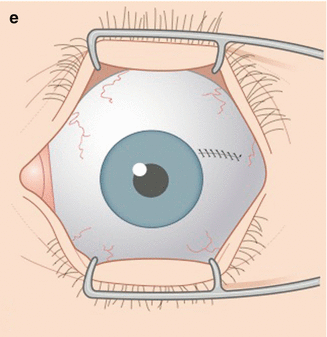
Fig. 21.1
Complex conjunctival excision. Large conjunctival lesion being excised with a 4-mm margin of unaffected conjunctiva. (a) Conjunctival flap being fashioned. (b) Partial-thickness scleral incision with a no. 57 Beaver blade. (c) Lamellar scleral dissection with a crescent blade. (d) Cryotherapy to the edges of the conjunctival wound. (e) Closure of the wound
21.5.2 Corneal Excision
As corneal involvement by a conjunctival tumor tends to be superficial, the corneal excision is usually limited to removal of corneal epithelium (corneal epitheliectomy). Care must be taken not to disrupt Bowman’s layer as it is thought to serve as a natural ocular barrier to invasion. Deeper invasion of the cornea, if present, necessitates lamellar keratectomy. Prior to scraping off the affected epithelium with no. 57 Beaver blade, absolute alcohol is applied for 1 min with a Weck-cell applicator to the involved corneal epithelium and a 2-mm margin of clinically non-affected tissue. The purpose of alcohol application is to denature the cells, thereby minimizing the risk of seeding of cancer cells. Alcohol is applied to dry cornea so as to limit spillage. The uninvolved cornea may also be protected with a viscoelastic applied to unaffected areas. The corneal epithelium is removed in one piece, placed on a sponge, and submitted to pathology.
An alternative approach is to first loosen and remove epithelium and then proceed with conjunctival resection of tumor.
21.5.3 Supplemental Cryotherapy
Cryotherapy with a flat-tipped nitrous oxide probe is used as a supplemental treatment of malignant lesions to decrease recurrence rates. Galor et al. demonstrated that application of cryotherapy to the surgical margins decreased the OSSN recurrence rate by approximately 50 % (31 % versus 16 % at 5 years) [5]. The probe is placed on the underside of the conjunctival edge, lifting the conjunctiva to avoid damage to the sclera, and applied to the tissue for 3–10 s (Fig. 21.1d) [4]. The tissue is allowed to thaw spontaneously and is refrozen in a similar manner for a “double freeze-thaw” cycle. The probe is applied to the margin to overlap with the previously treated area, and the process is repeated until all margins have been treated. The affected limbus is then similarly treated with a double freeze-thaw cycle.
21.5.4 Ocular Surface Reconstruction
To prevent the possibility of planting tumor cells on unaffected tissue, it is important to use a different set of instruments for reconstructing the ocular surface than those that were used for lesion removal. The preferred technique involves cutting an amniotic membrane to the appropriate size, placing it (substrate side down) over the defect area, and tucking the margins under the healthy conjunctivae. Fibrin glue is then utilized to secure the membrane to the underlying sclera. The thicker component (fibrinogen) is first introduced under the graft with a 27-gauge cannula and gently spread so that a thin layer of uniform thickness is achieved. The thinner component (thrombin) is then introduced under the graft with a separate cannula, and again, a thin layer is applied. A muscle hook is then used to smooth the graft and remove excess glue. Once graft position is acceptable, a 2-min wait is usually sufficient for good adherence to develop between the graft and underlying sclera (Fig. 21.1e). Use of amniotic membrane helps to decrease inflammation and to facilitate epithelialization [6–8].
21.6 Specific Surgical Techniques
21.6.1 Melanocytic Tumors
21.6.1.1 Conjunctival Nevus
Excision of conjunctival nevus is considered for cosmetic reasons, ocular irritation, or parental concern. A simple excisional biopsy is the procedure of choice [4].
21.6.1.2 Primary Acquired Melanosis
Because of the diffuse nature of primary acquired melanosis (PAM), the surgical approach is different from that of an isolated conjunctival lesion. Corneal epitheliectomy is performed if corneal involvement is documented. Suspicious nodules are excised to evaluate for the possibility of melanoma. Staging consists of removing 3-mm pieces of bulbar conjunctiva with the use of fresh forceps and scissors halfway between the rectus muscles and fornix in all four quadrants. These small areas can be left to heal without sutures [2]. Complete removal is possible with small areas of PAM, whereas diffuse areas may be treated with double freeze-thaw cycle cryotherapy alone (one quadrant per session) if atypia is documented histopathologically [9]. Topical mitomycin-C (MMC) has also been reported as a possible primary or adjuvant treatment for diffuse PAM [10, 11].
21.6.2 Squamous Tumors
21.6.2.1 Squamous Cell Papilloma
If removal is contemplated, combined modality treatment should be used since simple excision often leads to a more extensive recurrence than the original lesion [4]. Cryotherapy, as described above, is the supplemental treatment of choice. Alternatively, a medical approach using interferon alpha 2b drops or injections may be utilized.
21.6.2.2 Conjunctival Epithelial Neoplasia
Combined modality treatment (excision supplemented with cryotherapy) as described above is advocated given the high rate of recurrence of simple excision [4]. Other variations to the above technique have been described and include application of cryotherapy to the scleral bed as well as the surrounding conjunctivae [14] and performing cryosurgery prior to and after excision [3]. A variant of Mohs’ micrographic surgery has been described as an approach to treating CIN [15]. Topical interferon alpha [16, 17], topical MMC [18, 19], or topical 5-fluorouracil [20] can be used as an adjuvant treatment for patients with incompletely excised lesions (i.e., those with positive surgical margins). In patients with positive surgical margins, the use of postoperative interferon therapy reduced recurrences to a level similar to the one seen in patients with negative surgical margins [5]. Medical modalities can also be considered as a primary treatment, especially in patients with diffuse disease or in those with multiple recurrences after surgery [21].
< div class='tao-gold-member'>
Only gold members can continue reading. Log In or Register to continue
Stay updated, free articles. Join our Telegram channel

Full access? Get Clinical Tree


